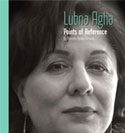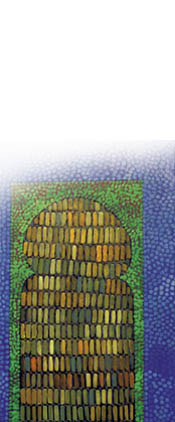(Excerpt from the book)
By Dr. Marcella Nesom Sirhandi
Art Critic and Historian on South Asian Art
Oklahoma State University
 |
Published by The Foundation of Museum of Modern Art (FOMMA), Karachi in 2007 ISBN Number: 969-8896-01-5 80 pages To obtain this monograph, please contact: FOMMA: www.fomma.info/contactus.php or email Lubna Agha: l.agha@comcast.net |
Infinity and Oneness
In 2004 Yusuf was invited to Morocco to teach at Al-Akhwayn University. Lubna took short leave of her graphic design position to visit her husband. Together they traveled to Casablanca and marveled at the “magnificent King Hassan II mosque”. They visited Marrakesh, Meknes, the ancient city of Fez and Ifrane. In each city the couple walked through and lingered at old madrasas, casbas, riads and the medinas (the Islamic university, the area around the rulers palace, palatial homes, and the market places, respectively). It was the first experience either of them had in North Africa. The following year the couple traveled to Turkey and visited the ancient sites of Ephesus and Capadocia. There Lubna witnessed Greek and Roman and Early Christian ruins. In Istanbul they found lodging in Sultanahmet next the Blue Mosque and Hagia Sofia. On both trips Lubna took hundreds of photos, architecture old and new, and details of painted and carved designs on common, everyday objects.
Photography had long been a passion with Lubna. Photographs were a way to preserve the memory of shapes, forms, colors and historical traditions, but were not taken with the intention of providing models for her art. In choosing what to shoot and framing the scene, Lubna looked closely and carefully at the subject. She noticed that Islamic pillars in Morocco were different from those in South Asia. This was true of other structural elements as well as common objects. She began to realize how much was taken for granted or simply overlooked in one’s culture. A desire to inspire a fresh vision of Islamic religious and cultural heritage became Lubna's challenge.
The fresh vision had less to do with iconography and design than with process and craftsmanship. Images that she chose to create were diverse, though all had a ready connection to Islamic art or culture. She painted a mosque pillar, a window within a window, a ceiling support for a chandelier, a pen box and rehel (Quran holder). The unifying element was the mark a dot or brush stroke no lines. The mark was repeated over and over. The surface was covered with dots and tiny dashes and curls, not unlike the pointillist paintings of Georges Seurat or the frenzied surfaces of Vincent Van Gogh. Lubna's density of dots and marks, though visually similar to those of the post-impressionists were philosophically very different. Repetition was a conscious physical act that emulated the repetitive actions of craftsmen producing a ware. The rhythmic beats of the hammer of an ironsmith, the chisel marks of the stonemason, or the sawing and sanding movements of the carpenter were relived with each dot and brush stroke.
Though exceptions abound, orthodox Islamic art avoided figurative imagery, floral designs excluded. Lubna honored the ban on representing living creatures, but her surfaces were brighter and more colorful than those on Islamic architecture. The patterns her pieces flaunted embodied the geometry and abstraction inherent in traditional Muslim architecture. Thousands of dots formed designs that might have come from Mughal mosaics, patterned brick walkways, diapered domed ceilings, jalis (intricately carved screens) or carved wooden staircases. It is well to remember, however, that Lubna was not trying to relive an historic tradition.
We must not assume a passive translation of a referent or an original preceding her creative act, but be careful to grant her role as an active aesthetic re-creator of these works. Agha, faithful to her modernist training, is insistent on foregrounding the here and now of her agency. She prefers not to be profiled as an antiquarian who only reluctantly acknowledges her modern conditions of existence, or who mutes her contemporary responses. Instead, she demands recognition as a modernist with modern aesthetic sensibilities, imbued with all modernism’s lately fledged myths while irresistibly drawn to the beautiful residues of an older world she has periodically encountered all her life, first as a youth, later as an accomplished photographer and always as an artist with an artist's eye.
Most of Lubna's recent work was done on wood. The wooden form was, in some cases, the art itself. In a craft shop in Morocco, Lubna came upon a wooden octagon 40" in diameter. It was painted bright red and decorated with green, yellow and white flowers. There was a supply of these ready-made ceiling forms in the shop. A customer would select one to attach to the ceiling of his riad and from it hang a chandelier. Lubna bought this ceiling mount, took it apart, carried it to Boston, reassembled it, and repainted it with thousands of dots. Presently attached to her wall, it might be replaced to the ceiling in the future.
Window within a window was inspired by the ogee type arched windows and niches in Morocco and Turkey. The small window within, however, suggested the viewing apparatus on the front door of a personal home. It also made reference to the mimbar, a majestic wooden throne accessed by a dozen or so steps where the Imam sat to conduct his sermon. Unconventional, however, is the color scheme. Pinks and blues that dominate are uncommon in architecture from this part of the Islamic world. The luminous, yet pastel hues call for reflection on the viewers part. The soft pastel colors and rigid geometric shapes were incongruous. So much the better, according to Lubna. It was a work of art, not a replica of anything that existed, and it should not have to convey philosophic or iconographic intent.
Two elaborate scroll cases hang horizontally above the doorway into and out of the Agha's Boston residence living room. These painted wooden panels maintained the same mark-covered surface as other images from this oeuvre. Like the ceiling panel, the cases derive from functional culture-specific objects. While pen boxes are more common than scroll cases, the latter provided an extended surface to paint. The central design in Scroll Case 1, an original creation by Lubna, has myriad precedents in local and regional architecture and artifacts. It recalls her long fascination with Chughtai's designs in Muraqqa-i-Chughtai. Similar calligraphic cartouches were found in Islamic book illustration and wall paintings. Scroll Case 2 also looks antique, but the overlaid dots and dabs refute any known historical technique.
Lubna's preoccupation with rehel (Quran book holder) exemplifies all facets of her current endeavor. While rehel are handmade and available in all the Islamic countries she visited, their beauty and originality tend to be taken for granted. They were intimately associated with Islam and completely functional. Interlocking wooden panels support the Quran when open and close flat to be stored away. Lubna painted three by mid summer 2006. The first two, painted on a flat surface, emulated the shape of a closed rehel. Lubna had collected a number of unique and intricately carved rehel from her foreign travels as well as from Pakistan. The three dimensional function was so vital to the essence of rehel that Lubna decided to paint the object itself. She did not want to corrupt the natural beauty of the examples she had collected so she had to have them made. She scoured the internet to find the right craftsman. After a number of phone calls and interviews, her choice might be thought odd. The craftsman was a craftswoman, was not Muslim or from an Islamic country, but hailed from Massachusetts and had never heard of rehel before Lubna sent her a drawing of what she wanted.
Whereas most rehel depend on carved design rather than color, Lubna's examples might seem contradictory. Reading the Quran was a sober undertaking and Lubna's hues were far from sober. On the other hand, rehel is a bookstand and reading was an enjoyable, needless to say, educational, pursuit.
In a recent exhibition in Canada, Lubna's work was complimented with architectural renderings by a contemporary Islamic architect. Writing in the exhibition catalog, curator Nadia Kurd observed the imposing presence of Lubna's paintings when juxtaposed against these architectural renderings.
In these works, not only do these images integrate elements of architecture but also incorporates a brushwork style consisting of points. This method of painting gives her subject matter a distinct brilliance in color and shape. The abstract images in her work challenge some of the immovable qualities of architecture to provide an ephemeral sense of two contradictory senses: infinity and oneness.


